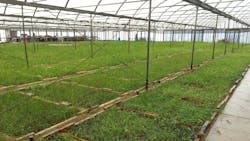Sometimes, perhaps by way of habit, traditional erosion control methods are selected for and used on a project because of just that—habit. Traditional erosion control methods such as native plantings, seeding, hydroseeding, and sod each have their benefits, but there’s another method worth considering. Flexible enough to be used on steep slopes, drainage swales, roadsides, retention basins, rain gardens, green roofs, shorelines, stream banks, wetlands, woodlands, and prairies, pre-vegetated blankets utilize traditional components in a not so traditional way.
At the core, pre-vegetated blankets contain all the components of traditional erosion control blankets with the added benefit of instant results. Unlike other, more traditional erosion control methods, pre-vegetated blankets provide both shoot and root coverage that add to the shear strength of the product upon installation.
You have likely seen different kinds of pre-vegetated blankets advertised, including pre-seeded, pre-grown, or monoculture. Most of these blankets are suited for specific applications and plant species. Some companies are marketing customizable blankets, but it’s still important to pay attention to the coverage rate and whether they are site-specific blankets. Some blankets are rolled and transported like sod, which can cause damage to the root system and the plant shoots, and if they’re left uninstalled, there’s a potential for overheating.
Highly effective pre-vegetated blankets are grown with native seed in coir fiber erosion control blankets, making them more versatile than some other current options. Pre-vegetated blankets offer the flexibility to be used on a multitude of project sites and can be grown with a native seed mix appropriate for the site based on soil type, sun exposure, slope, desired height, and even preferred bloom times and color—all the while utilizing the structural support of coir fiber erosion control blankets.
Many engineers and landscape professionals use four traditional methods of erosion control—native plantings, seeding, hydroseeding, and sod. Each has strengths and weaknesses.
Native Plantings
Native plants are extremely successful because they foster extensive root systems that help them survive under many local conditions, improve soil infiltration rates, and act as a net, holding sediment in place. Above ground, their thick stems reduce erosive energy by making a barrier that spreads out surface runoff to slow flow rates, drop sediment, and encourage infiltration. Native plant species have not only demonstrated effective erosion control on various types of projects, but they also help to mitigate water pollution, preserve wildlife, and diversify habitats.
Whether native plantings come in live plugs, as bare-root stock, or in containers, they all have one thing in common—they have established root systems and, when planted, take hold relatively quickly. Plantings can also be installed in a decorative manner, where drifts of color or texture provide visual interest.
The primary drawback to live container stock is the negative space between plants until they fill in enough to provide full coverage. This space is susceptible to washout during rain events or snowmelt until the plants mature. To reduce this space, plants are installed close together. Even though dense plantings have the secondary benefit of keeping weeds at bay, these plantings require upfront maintenance, consistent watering, and are still susceptible to washout with heavy rain events throughout the establishment phase. Native plants can also be pricy and time-consuming to install, especially if the site is difficult to prepare or has compacted soils.
Seeding
Seed, paired with erosion control blankets, is perhaps the most economical erosion control option. This duo provides immediate soil coverage followed by vegetative coverage and is completely customizable when it comes to seed mix selection as well as the type of erosion control blanket. It is important to note though that turf grass seed along with hay or straw is not recommended when seeding for erosion control specific projects.
While seeding can provide a clean and finished appearance, it does not provide the immediate aesthetic of sod or native plants. Seeding projects require weed control, monitoring, and irrigation. This method is also prone to washout with heavy rain events. There is also potential “critter” predation, primarily from squirrels, chipmunks, and birds.
Hydroseeding
One way to deter this kind of predation is to opt for hydroseeding. It is a great option because any grass seed can be mixed with mulch to create the slurry. The mulch provides moisture retention for faster germination; insulation from temperature extremes, which prevents seed dormancy; and protection from erosion. Hydroseeding provides a clean appearance with direct soil contact with initial moisture. Unlike hay or straw that is frequently specified on seeding jobs, mulch used in hydroseeding contains no weed seeds. Hydroseeding does not take as long to establish as seed and the results are usually visible as early as the first month.
Hydroseeding is, however, more susceptible to drying out with inadequate rain events or lack of maintenance and an uneven distribution of seed. Areas that have been hydroseeded need much more attention than other methods but handle disturbance as well as other methods. Costs tend to be moderate but, depending on the site, may require a soil stabilizer application, which is an added expense.
Sod
The primary benefit of using sod is its ability to provide immediate vegetation and complete soil coverage. It is grown and installed at full maturity. It reduces runoff rates and total soil losses because it is quick to establish, therefore preventing weed growth, minimizing the future need to use herbicides. Plus, sod can be laid in almost any season.
However, sod typically comes rolled on pallets and needs to be installed immediately for the best results. The root system only reaches a depth of 2 inches and tends to be susceptible to fungus, pests, and other diseases once installed. Sod is most vulnerable the first couple of weeks post-installation and excessive rain may even get the sod to float away.
When chosen and utilized properly, pre-vegetated blankets can take the best of these four methods and combine them, offering immediate vegetation, 100% soil coverage, a clean appearance, a well-established root (basal) system, and canopy coverage. However, it is important to understand the key components of pre-vegetated blankets to ensure the selected blanket meets the needs of the site.
The Nitty Gritty on Pre-Vegetated Blankets
The foundation of any pre-vegetated blanket is the erosion control blanket or mat. Biodegradable coir fiber erosion control mats provide immediate erosion control until roots can penetrate the soil to take hold and grow.
A mixture of growing media, enzymes, and fertilizer provides a bed of nutrients for desired seed mixes. Although this sounds simple, it is one of the most important steps in creating a healthy blanket. Nutrients and nutrient availability determine the success of growing healthy plants from seed—without access to both micro and macronutrients, vegetation would struggle to grow and is less likely to thrive.
The third component is seed. Seed selection is important, as the plants are the lasting aesthetic and component of a project. Seed selection should be based on site conditions and project goals. There are many knowledgeable native seed vendors who can recommend seed mixes based on project specifics. In addition, there are guidelines from governmental agencies such as Departments of Transportation, Departments of Natural Resources, and local conservation departments that work on a variety of projects and can provide direction on seed selection and plant requirements. Key things to remember when selecting native seed are choosing plants native to the site and appropriate for site conditions.
With all the components of the pre-vegetated blanket in place, it is time to let it grow. Growing pre-vegetated blankets requires consistency. Consistency in the process, consistency in temperature, and consistency in irrigation. Blankets typically require four to six weeks of lead time before they are ready for transportation and installation. The visible vegetative coverage ultimately depends on the mix and species of native plants selected for the blanket. Plants with narrow, grass-like foliage will not appear as full as a blanket containing more broadleaf forbs. Each type of plant species has its own germination and growth rates which are determined by seasonal changes, so some species in a seed mix may appear right away while others will need more time to develop.
Pre-vegetated blankets should yield at least 90% vegetative canopy coverage. While it is easier to measure the vegetative coverage of the canopy, like with sod, a pre-vegetated blanket offers a more reliable basal vegetative coverage that is difficult to measure. Pre-vegetated blankets provide this two-fold coverage upon installation, even when the top of the blanket seems thin or the canopy does not completely cover the surface of the blanket. A hidden layer of protection is provided by an intact root system providing excellent protection to disturbed soils in the field.
All in all, pre-vegetated blankets provide a non-traditional tool to combat erosion. They mimic nature’s way of taking care of erosive conditions—just with a little boost from human intervention. While more traditional erosion control methods will sometimes be the best site- and project-specific fit, pre-vegetated blankets, which can provide instantaneous coverage mature enough to withstand substantial rain events, are worth considering.
Carly Caris
Carly Caris writes on behalf of GreenLine Synergy LLC. She holds a Bachelor of Communication from Clarke University in Iowa.






